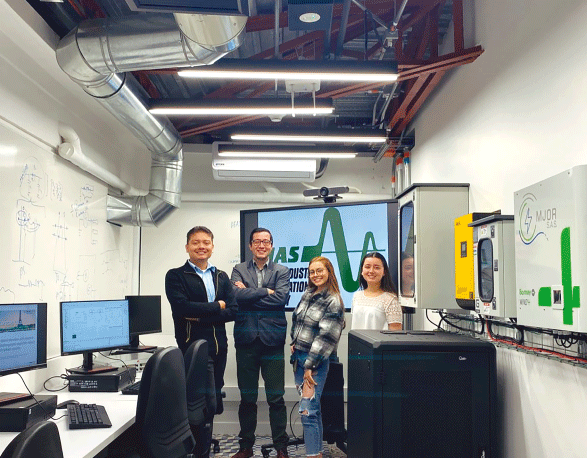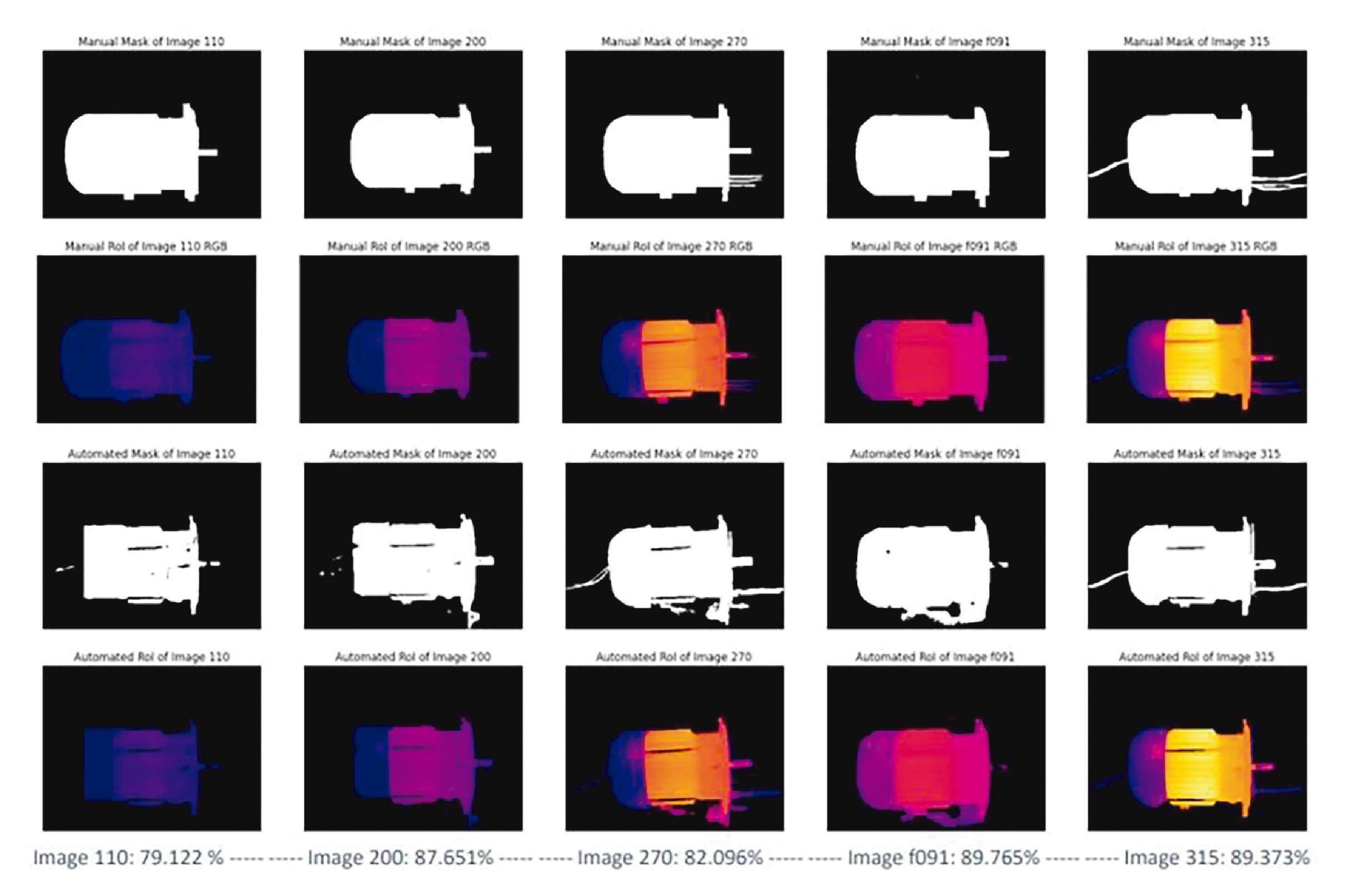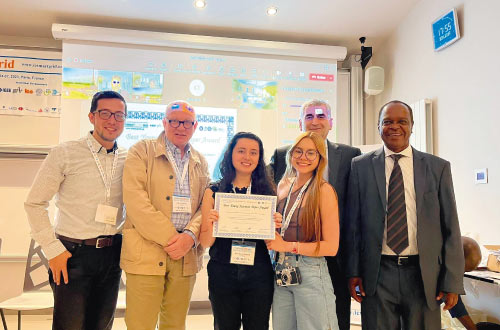Young talent for prevention in electrical systems
By: Felipe Gaitán García
Photos: EICT- URosarioDOI https://doi.org/10.12804/dvcn_10336.42691_num7
Science and Tech

By: Felipe Gaitán García
Photos: EICT- URosarioDOI https://doi.org/10.12804/dvcn_10336.42691_num7
When David Celeita Rodríguez, former director of the Energy Systems Engineering Program, promoted by the School of Engineering, Science and Technology at Universidad del Rosario, began to conceive his research, he recalled Marie Curie. The Polish scientist, a pioneer in the study and description of radioactivity, was the first woman to receive a Nobel Prize and the only person to date to win it in two different categories of science: physics (1903) and chemistry (1911). Thanks to their findings, the development of x-rays was achieved. Celeita Rodríguez evoked that revolutionary scientist because, if with electromagnetic waves it was possible to see the deepest part of human anatomy, her study allowed her to listen inside energy systems, as if it were an x-ray to electrical equipment to examine its state and diagnose or forecast possible damage.
At the beginning of 2023, while working as a professor of Universidad del Rosario, Celeita Rodríguez gathered an interdisciplinary group of undergraduate students in Applied Mathematics and Computer Science, as well as in Energy Systems Engineering, with the purpose of exploring the field of classification and intelligent detection of faults in electrical equipment by taking thermographic images, that is, photographs taken at a distance that allow the temperature of energy systems to identify defective functions. In his role as leader during that year, he guided students to be an essential part of the process of observation, analysis and disclosure, in an area of study that has gained relevance in the world.

Thermographic images of engines organized in five groups, analyzed with grayscale and corresponding Jaccard index, taken from the scientific paper Smart equipment failure detection with machine learning applied to thermography inspection data in modern power systems.
The idea to forge this project arose from a call from the Institute of Electrical and Electronic Engineers (IEEE), an organization based in New York (United States), that promotes scientific advances and innovations within these fields of knowledge. The primary requirement demanded by the American entity was that students should play a stellar role within the process.
In addition, the research team had the scientific backing of the assistant professor of Electronic Engineering and researcher of the French university Centrale Supélec, Trung Dung Le. This is how students Ana María Garzón, Natalia Laiton and Víctor Sicachá dared to contribute from their knowledge with the purpose of the study.
Soon the work deployed would begin to provide rewards for his still new academic life. The findings of his research activity were initially published in the IEEE indexed journal, through an article called “ Smart equipment failure detection with machine learning applied to thermography inspection data in modern power systems”.
One more will be released, two others have already been accepted and one remains under review. With this, the socialization stage of the project is in full consolidation and seeks a high impact within the industry in the short, medium and long term.
However, what is the research about, and why is it so relevant? As a first step, the team built a state of the art from which they were able to identify those similar studies that have been carried out around the world. From these works a database and images were set up.
Then came the experimental stage, which consisted of using infrared cameras to measure the temperature of electrical and electronic equipment, such as transformers and motors, in enclosed spaces. Once the thermographic images were achieved, artificial intelligence and machine learning techniques were used, with the intention of processing these photographs and introducing an algorithm that allowed their classification into clusters.

Ana María Garzón, a student of Applied Mathematics and Computer Science at URosario and member of the team that presented the research advances at the conference held in France, argues that “we are doing cutting-edge things, not only for Colombia and Latin America, but for the world...”
Within the study sample, 624 thermographic images were obtained (369 of induction motors and 255 of transformers). From an unsupervised machine learning method called vector support machine it was possible to classify the photographs of electrical equipment into two categories: hot and cold, which allowed to determine abnormal temperatures in the systems.
By using a grayscale, in addition to observing the pixels, it was possible to establish what type of damage could be identified. After that, the images were segmented to find the regions of interest. There, when removing the background of the photos obtained and focusing on a specific area of the devices, those that presented defects became evident; likewise, the characteristics found according to the grayscale configured elements to anticipate and predict eventual failures.
As a result of the procedure, defects were found in the systems with an accuracy of 90 percent, according to the Jaccard index, which measures the rate of similarity between two data sets. According to experts, this achievement contributes to the prediction of errors in electrical systems long before they occur and allows decisions to be made towards the future.
Celeita Rodríguez, who holds a master's degree and doctorate in Electrical Engineering, explains that the research is born from the idea of contributing to the development of the "internet of things" (a concept used to define a system of electronic devices interconnected through a wireless network and that allows sharing data or information) within power plants, especially in sectors such as industry and commerce, whose operation depends in large part on devices vulnerable to different types of disruptions.
“Many decades ago we worked only with analogous electrical signals, such as the use of thermostats to regulate temperature. Today, with the conjuncture of industry 4.0 (also called the fourth industrial revolution), which involves the use of artificial intelligence, digitalization, interconnectivity and data capture in real time, we can take infrared photographs and see how the equipment is inside, which allows us to obtain valuable information,” explains the researcher. Therefore, it is no longer just a question of capturing images of the present, but it is also possible to predict defects, in order to make proactive decisions, one of the main objectives of the project that he leads.
The value of detection and prediction
Humans have built a contemporary civilization that is based on electrical systems. In order for the dynamics of society to continue to develop smoothly, its proper functioning must be monitored and regular maintenance carried out. In this scenario, an inconsistency in any device, derived, for example, from an abnormal condition that alters the voltage or current, is capable of generating serious disturbances at large economic, social and human scales. A fire caused by a defect in a factory’s equipment not only leads to material losses, but also to a risk to workers’ lives.

Víctor Sicachá, a student of Applied Mathematics and Computer Science, adds that his contribution to the project has constituted a breaking point in his professional perspectives. “If I was not a researcher before, I may now have an open door to be one later. This team has given me that possibility.”
According to Professor Celeita, the conventional maintenance of electrical systems means the interruption in about 45 percent of operations, which also implies an economic investment in the evaluation of equipment. This has become a constant concern for the industrial sector. Therefore, the classification and detection of faults by thermal imaging are an effective and non-invasive option as a predictive method and prevention of defects that can scale and cause major damage.
When it comes to protection and inspection in the safety of operators, “human life is what prevails in the face of a possible alteration that can generate explosions of transformers and large volumes of energy,” Celeita emphasizes. Second is the team: “If we can protect it before catastrophe strikes, so much the better.” Identifying defects from thermal imaging thus helps to avoid disruption to essential electrical systems, such as housing, retail and hospital infrastructure. “By analyzing the photographs and exploring the inside of the devices, we become a kind of physician of the energy systems, to make preventive and proactive decisions,” he complements.
For Camilo Salazar Palacio, an electronic engineer from the Julio Garavito Colombian School of Engineering and a professor in the School of Exact Sciences and Engineering at Universidad Sergio Arboleda, “a system for predicting and detecting breakdowns early through the use of thermographic images, and with an adequate level of training, can substantially reduce accidents in any scenario.” It highlights that, for example, high temperatures can cause incidents such as short circuits and explosions, so being able to identify these anomalies in the operating ranges of the devices allows to reduce the occurrence of possible thermal accidents.
The impact of research
Although the exploration of thermographic images as a method of classifying and detecting faults in electrical equipment has gained space in various research centers around the world, in Colombia this approach has only just begun to occupy a preponderant place in energy systems engineering laboratories. It is for this reason that the study led by Universidad del Rosario has aroused the interest of academic institutions in Europe and the United States.
The project was driven by theParis Electronic Engineering Group (GeePs)of the Centrale Supélec University, and co-funded by theZucker Faculty Grant del IEEE, as well as by the School of Engineering, Science and Technology of Universidad del Rosario, the Society of Industry Applications (IAS) of the IEEE, and theIEEE Foundation, and the IEEE Foundation.
The awards for this team have not been long in coming. In June 2023, they received the Outstanding Young Scientist Award, as part of the 11th International Conference on Smart Grid(icSmart Grid) held in Paris.

Applied Mathematics and Computer Science students Ana María Garzón and Natalia Laiton received the Outstanding Young Scientist Award for their research at the Smart Grid 2023 in Paris, France.
“It is a milestone that undergraduate students achieve a certain prominence or visualization in international recognition,” Celeita Rodríguez highlights while sharing that academics and doctoral candidates from French engineering institutions were surprised to learn about the level of scientific work that is being developed at Universidad del Rosario. “It is very significant to realize that these industry interests can be linked from very early on during undergraduate training, in courses, in nurseries and in research groups,” he emphasizes.
On her part, Ana María Garzón, a student of Applied Mathematics and Computer Science at the institution and member of the team that presented the advances of research at the congress held in France, argues that “we are doing cutting-edge things, not only for Colombia and Latin America, but for the world. I believe that high-level research is being done at Universidad del Rosario. Being able to participate in the conference I learned a lot from the industry.” In addition, she notes that thermographic imaging is relatively new, so finding datasets that show faults and the information required is not so straightforward. All this, in her opinion, is a great reward for the work ahead.
Meanwhile, Víctor Sicachá, also a student of Applied Mathematics and Computer Science, adds that his contribution to the project has constituted a breaking point in his professional perspectives. “If I was not a researcher before, I may now have an open door to be one later. This team has given me that possibility.”

Natalia Laiton, student of Applied Mathematics and Computer Science, was also part of the research team and decided to contribute from her knowledge for the purpose of the study.
Prospects for the future
One of the objectives of the project is to extend its focus of study towards energy systems in open spaces, such as photovoltaic solar panels, which are currently in vogue today due to the imminent energy transition. This implies an effort in terms of exploration, but also an economic challenge.
Replicating the project's thermal imaging model in open space systems means greater investment in research and technology. Drones and thermal cameras are needed, among other tools that are relatively expensive. Today, says Professor Celeita Rodríguez, those who develop thermography have enough infrastructure to monitor equipment in closed spaces, but the field of action is migrating to open areas. “We are going there, we are in the process of acquiring the thermal camera and thus being able to work with our own equipment,” he concludes.
In October of last year, the team was invited to a conference in Nashville (United States) to present the progress of their project and socialize a new publication that describes their scientific findings, with which the scope of the study continues to expand. Meanwhile, in the URosario Renewable Energy Laboratory, which operates with solar panels and a wind turbine located on the building’s roof, students continue to debate and build the course of their research together.